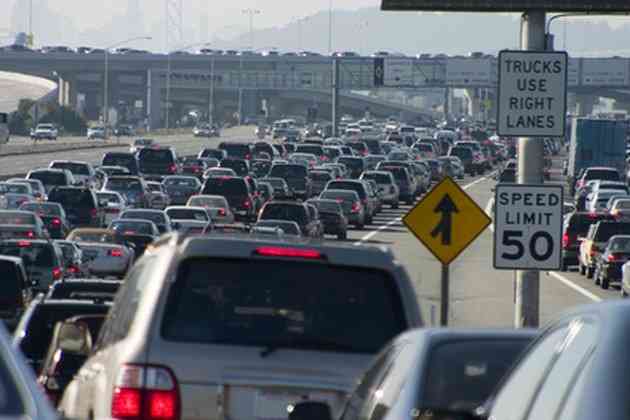The Causes, Effects & Solutions for Air Pollution

Vehicles crowding roadways, power plants pumping smoke and chemicals from consumer products have many people thinking about air pollution and how it affects the planet. Air pollution is a complicated problem with many causes and effects and few solutions. Reducing air pollution and its effects will require the cooperation of people everywhere.

Definition
The general term “air pollution” refers to “undesirable amounts of particulate or gaseous matter in the atmosphere” according to the California Environmental Protection Agency's Air Resources Board. Air pollution can occur naturally during a forest fire, dust storm or volcanic eruption, but the biggest source of pollution for the past 100 years has been humankind.
Causes
The two main forms of outdoor air pollution include particulate matter, sometimes called black carbon pollution, and noxious gases. Burning fossil fuels to power vehicles, homes and industrial plants releases tiny particles of matter into the air, according to information from the Lawrence Berkeley National Laboratory. Noxious gases such as carbon monoxide, sulfur dioxide and nitrogen oxide react with the sun to create new and dangerous compounds, including smog and acid rain. Dr. Cheryl E. Merritt of the Yale-New Haven Teachers Institute reports that carbon monoxide accounts for the majority of pollution from human activity and that exhaust creates most of that carbon monoxide.
Effects
The particulate matter and noxious gases floating in the atmosphere can trap solar heat in a process known as the greenhouse effect. Ideally, the sun's rays should penetrate the atmosphere and the Earth's surface should reflect excess radiation back out of the atmosphere. However, air pollution bounces some of that excess heat back down to Earth and contributes to climate change. The Environmental Protection Agency reports on its website that if the current trend of rising temperatures continues, it could lead to the melting of the polar icebergs, rising sea levels and flooding in coastal areas. Air pollution's destruction of the ozone layer exacerbates the problem of the greenhouse effect and leads to its own complications. The ozone layer serves as a filter limiting the sun's ultraviolet, or UV, radiation entering the atmosphere. Chlorofluorocarbons, or CFCs, carbon dioxide and other ozone depleters react with the sun's radiation and break down to their component atoms, which then rob the ozone of oxygen atoms. Currently, the ozone layer's concentration decreases by about 2 percent each year, allowing for more and more UV radiation to reach the Earth's surface. The increase in radiation can cause skin cancer, damage to the human immune system and eye damage. It also kills small aquatic organisms like plankton, affecting marine food chains and releasing additional carbon dioxide into the atmosphere when the life forms decompose.
Considerations
Many people are affected by air pollution, whether or not they know it. FuelEconomy.gov reports that in 2007, about 150 million Americans lived in areas where monitored air pollution reached unhealthy levels. Although industry does cause air pollution, the vehicles crowding the highways produce many, if not most, of the chemicals that cause smog and pollution-related health problems.
Prevention/Solution
In this industrial age, air pollution cannot be eliminated completely, but steps can be taken to reduce it. The government has developed, and continues to develop, guidelines for air quality and ordinances to restrict emissions in an effort to control air pollution, reports Dr. Cheryl E. Merritt of the Yale-New Haven Teachers Institute. On an individual level, you can reduce your contribution to the pollution problem by carpooling or using public transportation. Additionally, buying energy-efficient light bulbs and appliances or otherwise reducing your electricity use will reduce the pollutants released in the production of electricity, which creates the majority of America's industrial air pollution, according to the Oberlin College Resource Conservation Team.




